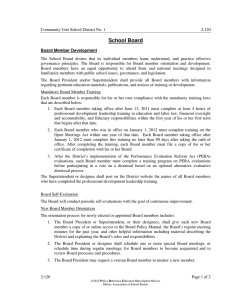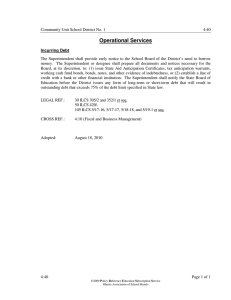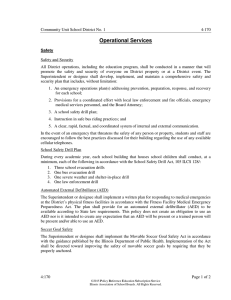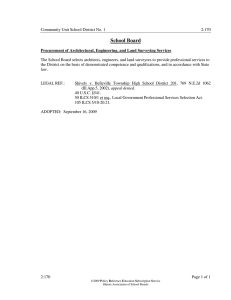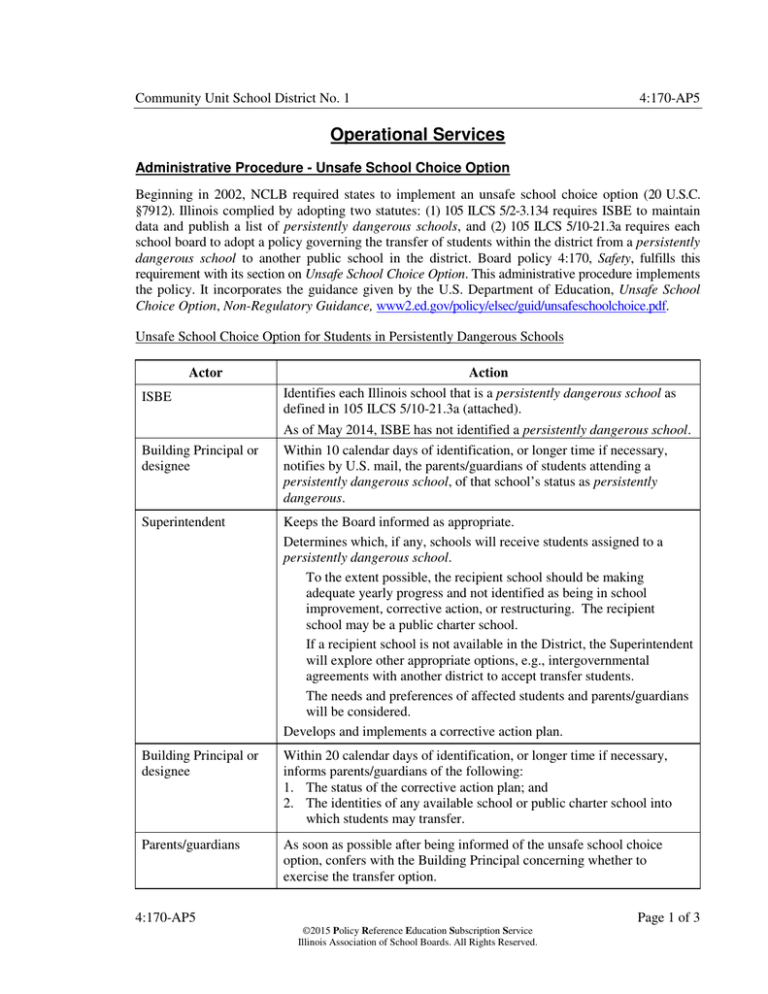
Community Unit School District No. 1
4:170-AP5
Operational Services
Administrative Procedure - Unsafe School Choice Option
Beginning in 2002, NCLB required states to implement an unsafe school choice option (20 U.S.C.
§7912). Illinois complied by adopting two statutes: (1) 105 ILCS 5/2-3.134 requires ISBE to maintain
data and publish a list of persistently dangerous schools, and (2) 105 ILCS 5/10-21.3a requires each
school board to adopt a policy governing the transfer of students within the district from a persistently
dangerous school to another public school in the district. Board policy 4:170, Safety, fulfills this
requirement with its section on Unsafe School Choice Option. This administrative procedure implements
the policy. It incorporates the guidance given by the U.S. Department of Education, Unsafe School
Choice Option, Non-Regulatory Guidance, www2.ed.gov/policy/elsec/guid/unsafeschoolchoice.pdf.
Unsafe School Choice Option for Students in Persistently Dangerous Schools
Actor
ISBE
Action
Identifies each Illinois school that is a persistently dangerous school as
defined in 105 ILCS 5/10-21.3a (attached).
Building Principal or
designee
As of May 2014, ISBE has not identified a persistently dangerous school.
Within 10 calendar days of identification, or longer time if necessary,
notifies by U.S. mail, the parents/guardians of students attending a
persistently dangerous school, of that school’s status as persistently
dangerous.
Superintendent
Keeps the Board informed as appropriate.
Determines which, if any, schools will receive students assigned to a
persistently dangerous school.
To the extent possible, the recipient school should be making
adequate yearly progress and not identified as being in school
improvement, corrective action, or restructuring. The recipient
school may be a public charter school.
If a recipient school is not available in the District, the Superintendent
will explore other appropriate options, e.g., intergovernmental
agreements with another district to accept transfer students.
The needs and preferences of affected students and parents/guardians
will be considered.
Develops and implements a corrective action plan.
Building Principal or
designee
Within 20 calendar days of identification, or longer time if necessary,
informs parents/guardians of the following:
1. The status of the corrective action plan; and
2. The identities of any available school or public charter school into
which students may transfer.
Parents/guardians
As soon as possible after being informed of the unsafe school choice
option, confers with the Building Principal concerning whether to
exercise the transfer option.
4:170-AP5
Page 1 of 3
©2015 Policy Reference Education Subscription Service
Illinois Association of School Boards. All Rights Reserved.
Actor
Action
Building Principal or
designee
Executes any requested transfers as soon as possible. Transfers will be in
effect at least while the original school is identified as persistently
dangerous. When determining the transfer length, the Principal considers
the student’s educational needs as well as other factors affecting the
student’s ability to succeed if returned to the transferring school.
Superintendent or
designee
Upon corrective action plan’s completion, requests that ISBE remove the
school from the list of persistently dangerous schools.
Unsafe School Choice Option for Any Student Who Is a Victim of a Violent Criminal Offense
Occurring on School Grounds During Regular School Hours or During a School-Sponsored Event
Actor
Action
Building Principal or
designee
Notifies the Superintendent that a student was a victim of a violent crime,
as defined by 725 ILCS 120/3 (attached), occurring on school grounds
during regular school hours or during a school-sponsored event.
Superintendent
As soon as possible, determines which, if any, schools are available
recipients for a student who was a victim of a violent crime while in
school or on school grounds.
To the extent possible, the recipient school should be making
adequate yearly progress and has not been identified as being in
school improvement, corrective action, or restructuring. The
recipient school may be a public charter school.
If a recipient school is not available in the District, the Superintendent
will explore other appropriate options, e.g., an agreement with a
neighboring district to accept the student.
The needs and preferences of the affected student and his or her
parents/guardians shall be considered.
Keeps the Board informed as appropriate.
Building Principal or
designee
As soon as possible, notifies the student’s parents/guardians that the
student may transfer to another school, provided another school is
available.
Parents/guardians
As soon as possible after being informed of the unsafe school choice
option, confers with the Building Principal concerning whether to
exercise the transfer option.
Building Principal or
designee
Executes any requested transfer as soon as possible. When determining
the transfer length, considers the student’s educational needs as well as
other factors affecting the student’s ability to succeed if returned to the
transferring school.
***********************************************************************************
Definitions for “Persistently Dangerous School”
105 ILCS 5/10-21.3a
4:170-AP5
Page 2 of 3
©2015 Policy Reference Education Subscription Service
Illinois Association of School Boards. All Rights Reserved.
§10-21.3a(b). In order to be considered a persistently dangerous school, the school must meet all of
the following criteria for 2 consecutive years:
1. Have greater than 3% of the students enrolled in the school expelled for violencerelated conduct;
2. Have one or more students expelled for bringing a firearm to school as defined in 18
U.S.C. 921;
3. Have at least 3% of students enrolled in the school exercise the individual option to
transfer schools pursuant to subsection (c) of this section. [105 ILCS 5/10-21.3a(c), see
the second section of this procedure]
Definitions for “Crime Victim” and “Violent Crime”
725 ILCS 120/3 (current as of May 2014)
§ 3.
The terms used in this Act, unless the context clearly requires otherwise, shall have the
following meanings:
(a) "Crime victim" means (1) a person physically injured in this State as a result of a
violent crime perpetrated or attempted against that person or (2) a person who suffers injury
to or loss of property as a result of a violent crime perpetrated or attempted against that
person or (3) a single representative who may be the spouse, parent, child or sibling of a
person killed as a result of a violent crime perpetrated against the person killed or the
spouse, parent, child or sibling of any person granted rights under this Act who is
physically or mentally incapable of exercising such rights, except where the spouse, parent,
child or sibling is also the defendant or prisoner or (4) any person against whom a violent
crime has been committed or (5) any person who has suffered personal injury as a result of
a violation of Section 11-501 of the Illinois Vehicle Code, or of a similar provision of a
local ordinance, or of Section 9-3 of the Criminal Code of 1961 or the Criminal Code of
2012, as amended; [.]
(c) "Violent Crime" means any felony in which force or threat of force was used against
the victim, or any offense involving sexual exploitation, sexual conduct or sexual
penetration, domestic battery, violation of an order of protection, stalking, or any
misdemeanor which results in death or great bodily harm to the victim or any violation of
Section 9-3 of the Criminal Code of 1961 or the Criminal Code of 2012, or Section 11-501
of the Illinois Vehicle Code, or a similar provision of a local ordinance, if the violation
resulted in personal injury or death, and includes any action committed by a juvenile that
would be a violent crime if committed by an adult. For the purposes of this paragraph,
"personal injury" shall include any Type A injury as indicated on the traffic accident report
completed by a law enforcement officer that requires immediate professional attention in
either a doctor's office or medical facility. A Type A injury shall include severely bleeding
wounds, distorted extremities, and injuries that require the injured party to be carried from
the scene; [.]
ADOPTED:
July 15, 2015
4:170-AP5
Page 3 of 3
©2015 Policy Reference Education Subscription Service
Illinois Association of School Boards. All Rights Reserved.


